BHM206 - Service Marketing: Case Study Analysis of 7-Eleven Taiwan
VerifiedAdded on 2023/06/11
|10
|2519
|394
Case Study
AI Summary
This case study analyzes 7-Eleven's service marketing strategies in Taiwan, focusing on its background, target market, marketing conditions, and positioning. It identifies key aspects of the case study concerning service marketing principles and theories, such as consumer purchase behavior, pricing strategies, and social media marketing. The analysis evaluates practices implemented by 7-Eleven, highlighting both successes and areas needing improvement, particularly in human resource management. The report concludes with specific recommendations for the organization's further development, including forming strategic partnerships, addressing employee workload issues, and improving communication with suppliers, emphasizing the need for a systematic approach to change management. Desklib provides access to this and other solved assignments for students.
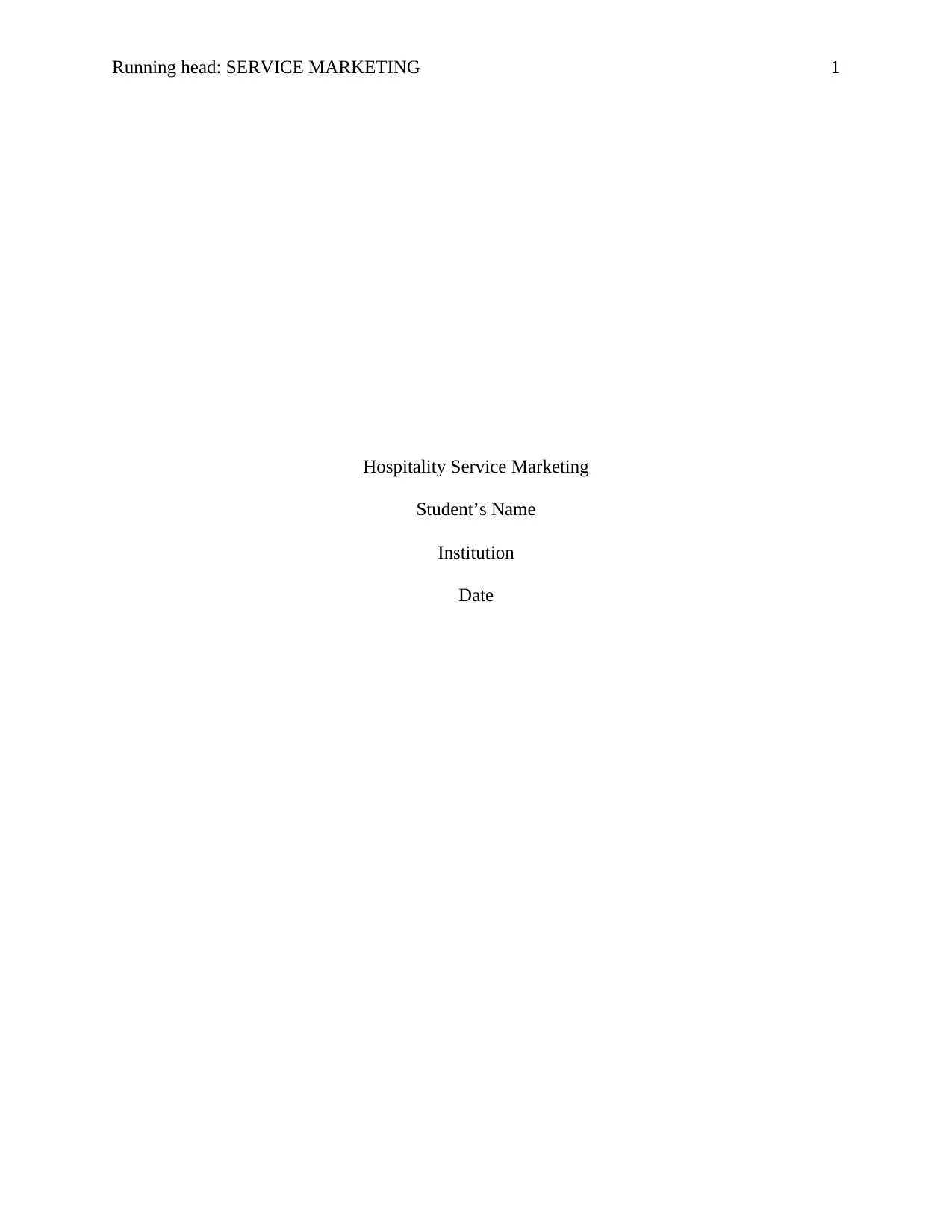
Running head: SERVICE MARKETING 1
Hospitality Service Marketing
Student’s Name
Institution
Date
Hospitality Service Marketing
Student’s Name
Institution
Date
Paraphrase This Document
Need a fresh take? Get an instant paraphrase of this document with our AI Paraphraser
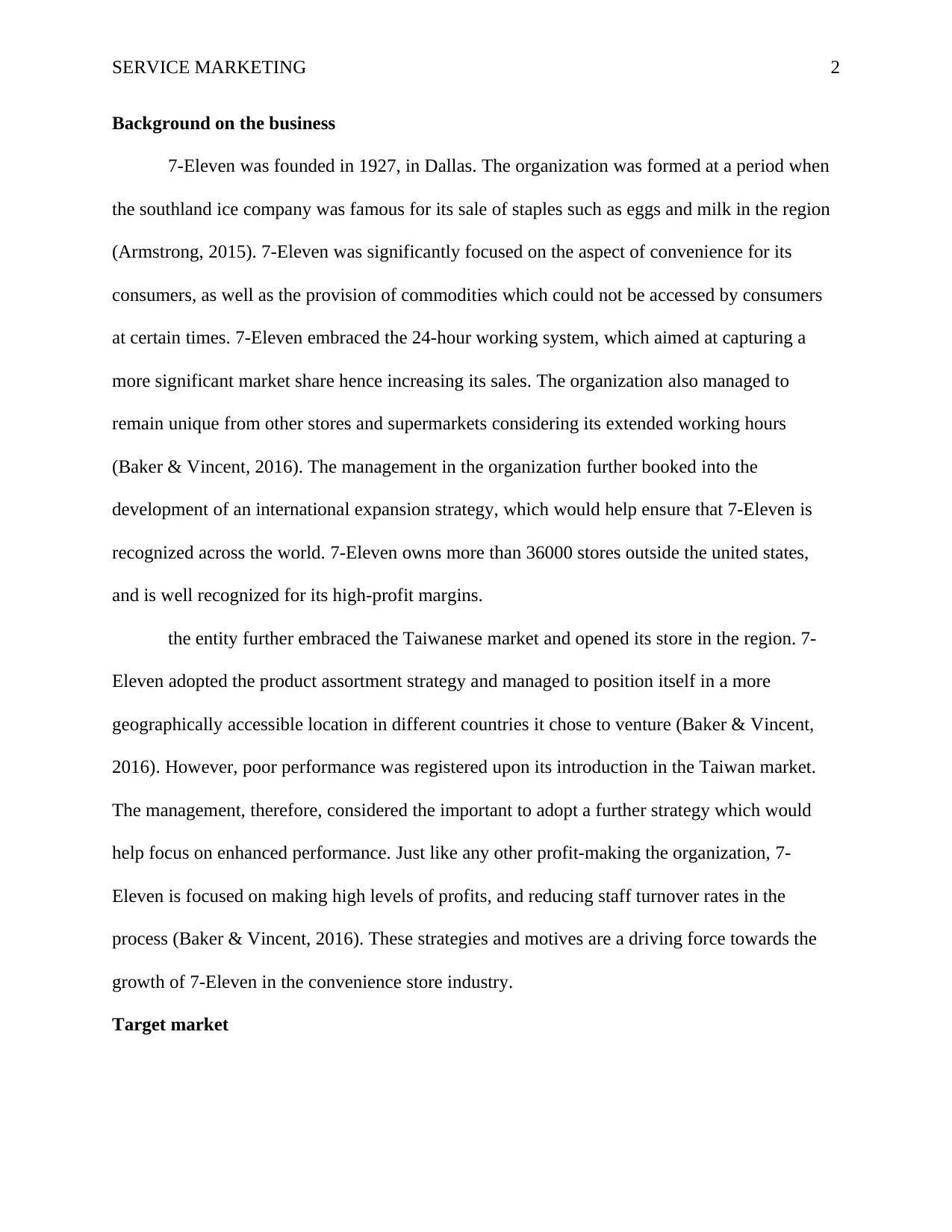
SERVICE MARKETING 2
Background on the business
7-Eleven was founded in 1927, in Dallas. The organization was formed at a period when
the southland ice company was famous for its sale of staples such as eggs and milk in the region
(Armstrong, 2015). 7-Eleven was significantly focused on the aspect of convenience for its
consumers, as well as the provision of commodities which could not be accessed by consumers
at certain times. 7-Eleven embraced the 24-hour working system, which aimed at capturing a
more significant market share hence increasing its sales. The organization also managed to
remain unique from other stores and supermarkets considering its extended working hours
(Baker & Vincent, 2016). The management in the organization further booked into the
development of an international expansion strategy, which would help ensure that 7-Eleven is
recognized across the world. 7-Eleven owns more than 36000 stores outside the united states,
and is well recognized for its high-profit margins.
the entity further embraced the Taiwanese market and opened its store in the region. 7-
Eleven adopted the product assortment strategy and managed to position itself in a more
geographically accessible location in different countries it chose to venture (Baker & Vincent,
2016). However, poor performance was registered upon its introduction in the Taiwan market.
The management, therefore, considered the important to adopt a further strategy which would
help focus on enhanced performance. Just like any other profit-making the organization, 7-
Eleven is focused on making high levels of profits, and reducing staff turnover rates in the
process (Baker & Vincent, 2016). These strategies and motives are a driving force towards the
growth of 7-Eleven in the convenience store industry.
Target market
Background on the business
7-Eleven was founded in 1927, in Dallas. The organization was formed at a period when
the southland ice company was famous for its sale of staples such as eggs and milk in the region
(Armstrong, 2015). 7-Eleven was significantly focused on the aspect of convenience for its
consumers, as well as the provision of commodities which could not be accessed by consumers
at certain times. 7-Eleven embraced the 24-hour working system, which aimed at capturing a
more significant market share hence increasing its sales. The organization also managed to
remain unique from other stores and supermarkets considering its extended working hours
(Baker & Vincent, 2016). The management in the organization further booked into the
development of an international expansion strategy, which would help ensure that 7-Eleven is
recognized across the world. 7-Eleven owns more than 36000 stores outside the united states,
and is well recognized for its high-profit margins.
the entity further embraced the Taiwanese market and opened its store in the region. 7-
Eleven adopted the product assortment strategy and managed to position itself in a more
geographically accessible location in different countries it chose to venture (Baker & Vincent,
2016). However, poor performance was registered upon its introduction in the Taiwan market.
The management, therefore, considered the important to adopt a further strategy which would
help focus on enhanced performance. Just like any other profit-making the organization, 7-
Eleven is focused on making high levels of profits, and reducing staff turnover rates in the
process (Baker & Vincent, 2016). These strategies and motives are a driving force towards the
growth of 7-Eleven in the convenience store industry.
Target market
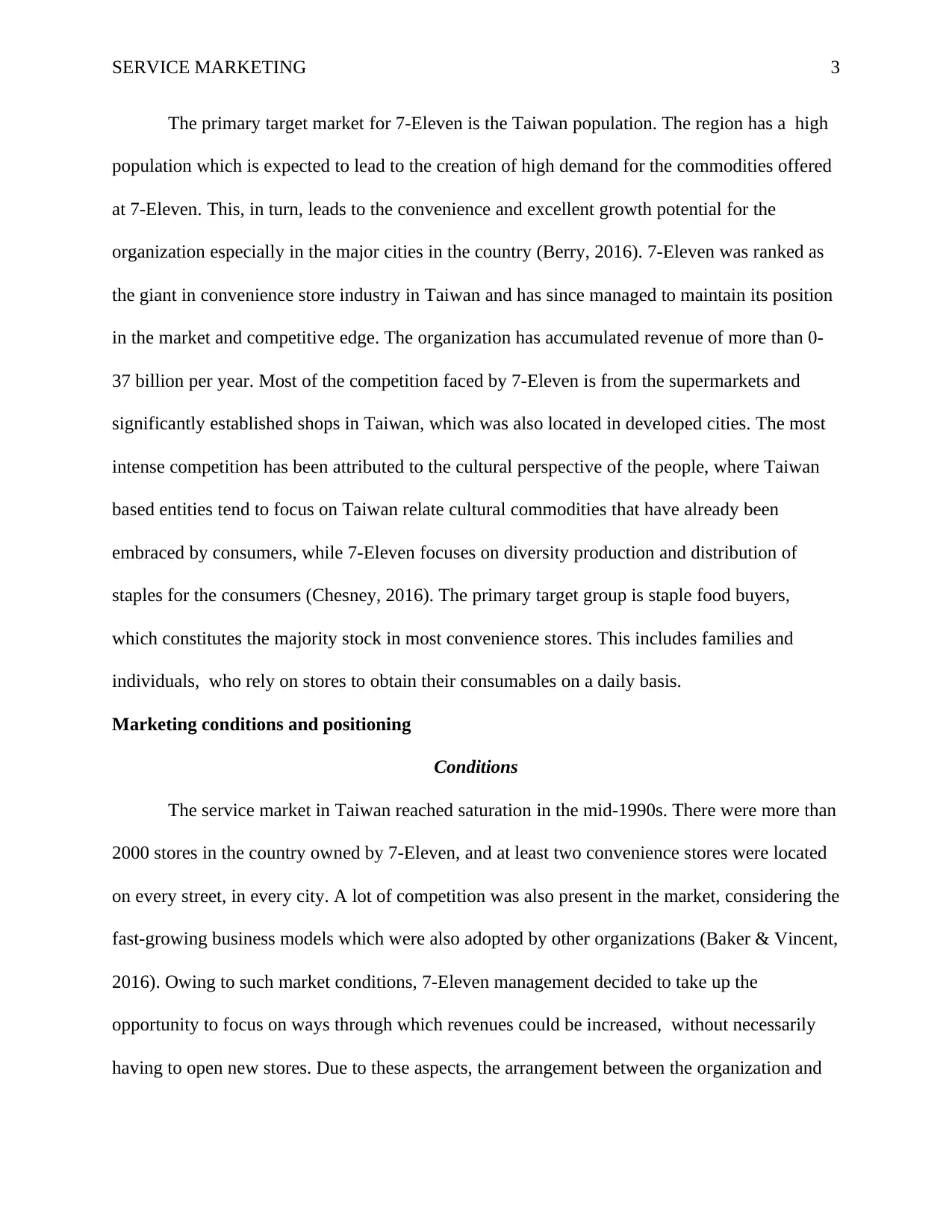
SERVICE MARKETING 3
The primary target market for 7-Eleven is the Taiwan population. The region has a high
population which is expected to lead to the creation of high demand for the commodities offered
at 7-Eleven. This, in turn, leads to the convenience and excellent growth potential for the
organization especially in the major cities in the country (Berry, 2016). 7-Eleven was ranked as
the giant in convenience store industry in Taiwan and has since managed to maintain its position
in the market and competitive edge. The organization has accumulated revenue of more than 0-
37 billion per year. Most of the competition faced by 7-Eleven is from the supermarkets and
significantly established shops in Taiwan, which was also located in developed cities. The most
intense competition has been attributed to the cultural perspective of the people, where Taiwan
based entities tend to focus on Taiwan relate cultural commodities that have already been
embraced by consumers, while 7-Eleven focuses on diversity production and distribution of
staples for the consumers (Chesney, 2016). The primary target group is staple food buyers,
which constitutes the majority stock in most convenience stores. This includes families and
individuals, who rely on stores to obtain their consumables on a daily basis.
Marketing conditions and positioning
Conditions
The service market in Taiwan reached saturation in the mid-1990s. There were more than
2000 stores in the country owned by 7-Eleven, and at least two convenience stores were located
on every street, in every city. A lot of competition was also present in the market, considering the
fast-growing business models which were also adopted by other organizations (Baker & Vincent,
2016). Owing to such market conditions, 7-Eleven management decided to take up the
opportunity to focus on ways through which revenues could be increased, without necessarily
having to open new stores. Due to these aspects, the arrangement between the organization and
The primary target market for 7-Eleven is the Taiwan population. The region has a high
population which is expected to lead to the creation of high demand for the commodities offered
at 7-Eleven. This, in turn, leads to the convenience and excellent growth potential for the
organization especially in the major cities in the country (Berry, 2016). 7-Eleven was ranked as
the giant in convenience store industry in Taiwan and has since managed to maintain its position
in the market and competitive edge. The organization has accumulated revenue of more than 0-
37 billion per year. Most of the competition faced by 7-Eleven is from the supermarkets and
significantly established shops in Taiwan, which was also located in developed cities. The most
intense competition has been attributed to the cultural perspective of the people, where Taiwan
based entities tend to focus on Taiwan relate cultural commodities that have already been
embraced by consumers, while 7-Eleven focuses on diversity production and distribution of
staples for the consumers (Chesney, 2016). The primary target group is staple food buyers,
which constitutes the majority stock in most convenience stores. This includes families and
individuals, who rely on stores to obtain their consumables on a daily basis.
Marketing conditions and positioning
Conditions
The service market in Taiwan reached saturation in the mid-1990s. There were more than
2000 stores in the country owned by 7-Eleven, and at least two convenience stores were located
on every street, in every city. A lot of competition was also present in the market, considering the
fast-growing business models which were also adopted by other organizations (Baker & Vincent,
2016). Owing to such market conditions, 7-Eleven management decided to take up the
opportunity to focus on ways through which revenues could be increased, without necessarily
having to open new stores. Due to these aspects, the arrangement between the organization and
⊘ This is a preview!⊘
Do you want full access?
Subscribe today to unlock all pages.

Trusted by 1+ million students worldwide
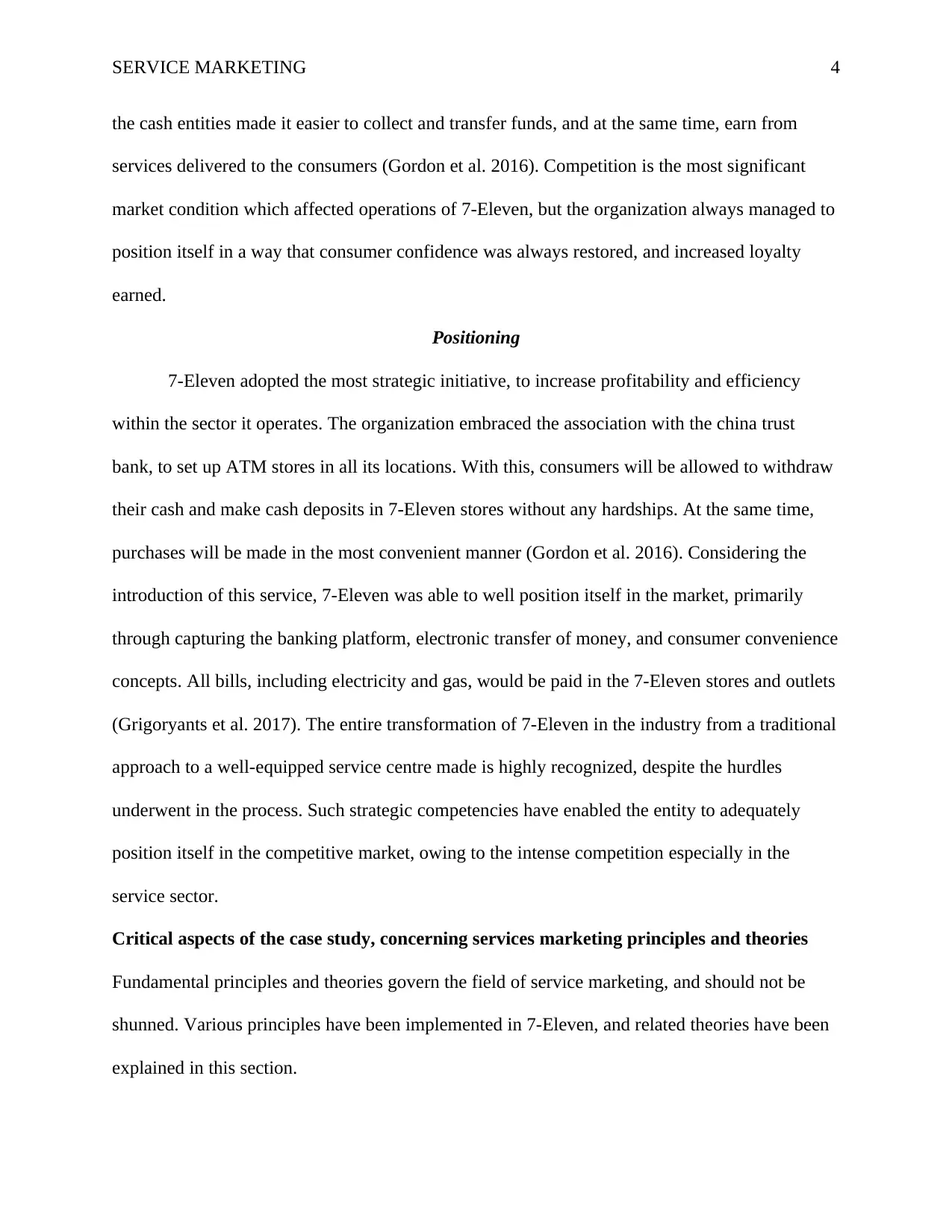
SERVICE MARKETING 4
the cash entities made it easier to collect and transfer funds, and at the same time, earn from
services delivered to the consumers (Gordon et al. 2016). Competition is the most significant
market condition which affected operations of 7-Eleven, but the organization always managed to
position itself in a way that consumer confidence was always restored, and increased loyalty
earned.
Positioning
7-Eleven adopted the most strategic initiative, to increase profitability and efficiency
within the sector it operates. The organization embraced the association with the china trust
bank, to set up ATM stores in all its locations. With this, consumers will be allowed to withdraw
their cash and make cash deposits in 7-Eleven stores without any hardships. At the same time,
purchases will be made in the most convenient manner (Gordon et al. 2016). Considering the
introduction of this service, 7-Eleven was able to well position itself in the market, primarily
through capturing the banking platform, electronic transfer of money, and consumer convenience
concepts. All bills, including electricity and gas, would be paid in the 7-Eleven stores and outlets
(Grigoryants et al. 2017). The entire transformation of 7-Eleven in the industry from a traditional
approach to a well-equipped service centre made is highly recognized, despite the hurdles
underwent in the process. Such strategic competencies have enabled the entity to adequately
position itself in the competitive market, owing to the intense competition especially in the
service sector.
Critical aspects of the case study, concerning services marketing principles and theories
Fundamental principles and theories govern the field of service marketing, and should not be
shunned. Various principles have been implemented in 7-Eleven, and related theories have been
explained in this section.
the cash entities made it easier to collect and transfer funds, and at the same time, earn from
services delivered to the consumers (Gordon et al. 2016). Competition is the most significant
market condition which affected operations of 7-Eleven, but the organization always managed to
position itself in a way that consumer confidence was always restored, and increased loyalty
earned.
Positioning
7-Eleven adopted the most strategic initiative, to increase profitability and efficiency
within the sector it operates. The organization embraced the association with the china trust
bank, to set up ATM stores in all its locations. With this, consumers will be allowed to withdraw
their cash and make cash deposits in 7-Eleven stores without any hardships. At the same time,
purchases will be made in the most convenient manner (Gordon et al. 2016). Considering the
introduction of this service, 7-Eleven was able to well position itself in the market, primarily
through capturing the banking platform, electronic transfer of money, and consumer convenience
concepts. All bills, including electricity and gas, would be paid in the 7-Eleven stores and outlets
(Grigoryants et al. 2017). The entire transformation of 7-Eleven in the industry from a traditional
approach to a well-equipped service centre made is highly recognized, despite the hurdles
underwent in the process. Such strategic competencies have enabled the entity to adequately
position itself in the competitive market, owing to the intense competition especially in the
service sector.
Critical aspects of the case study, concerning services marketing principles and theories
Fundamental principles and theories govern the field of service marketing, and should not be
shunned. Various principles have been implemented in 7-Eleven, and related theories have been
explained in this section.
Paraphrase This Document
Need a fresh take? Get an instant paraphrase of this document with our AI Paraphraser
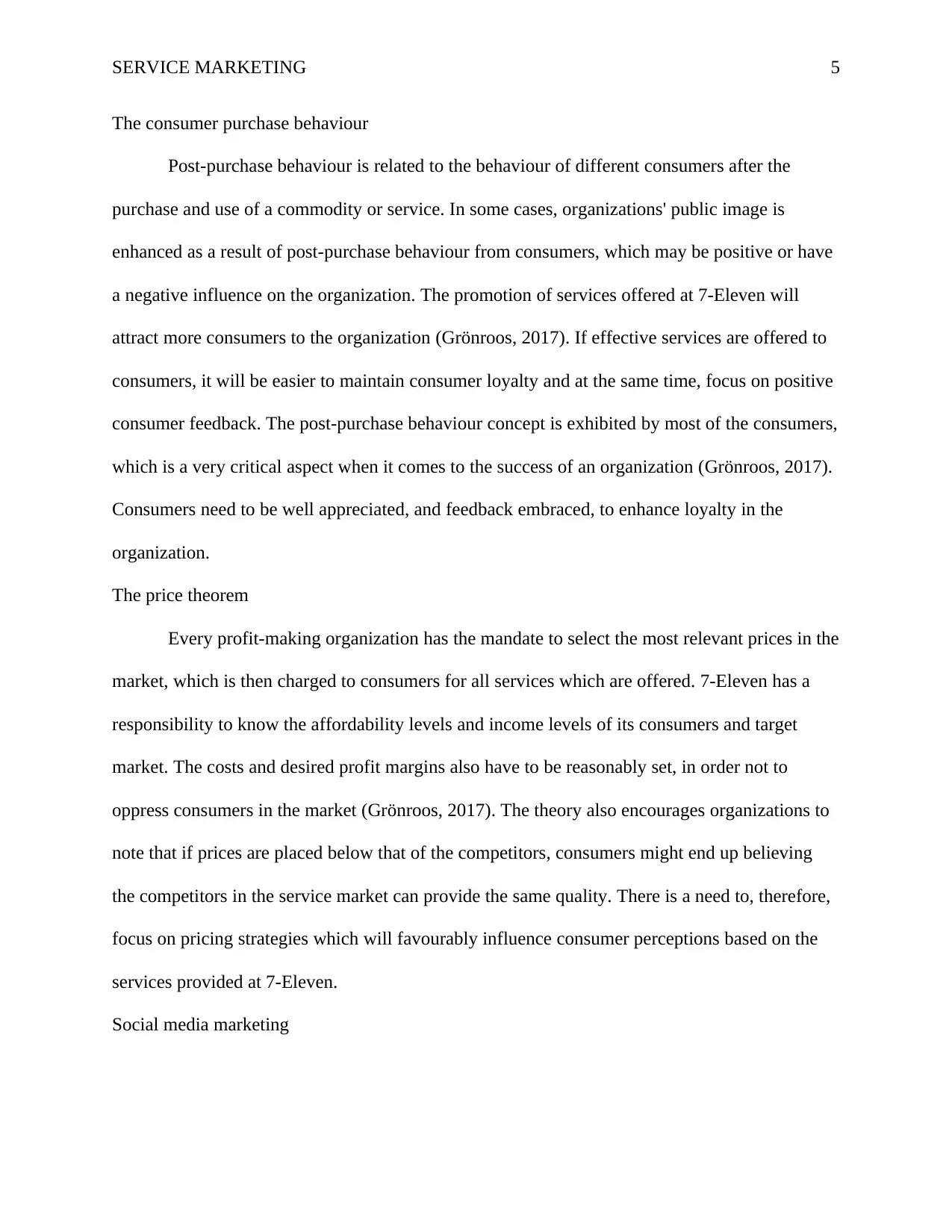
SERVICE MARKETING 5
The consumer purchase behaviour
Post-purchase behaviour is related to the behaviour of different consumers after the
purchase and use of a commodity or service. In some cases, organizations' public image is
enhanced as a result of post-purchase behaviour from consumers, which may be positive or have
a negative influence on the organization. The promotion of services offered at 7-Eleven will
attract more consumers to the organization (Grönroos, 2017). If effective services are offered to
consumers, it will be easier to maintain consumer loyalty and at the same time, focus on positive
consumer feedback. The post-purchase behaviour concept is exhibited by most of the consumers,
which is a very critical aspect when it comes to the success of an organization (Grönroos, 2017).
Consumers need to be well appreciated, and feedback embraced, to enhance loyalty in the
organization.
The price theorem
Every profit-making organization has the mandate to select the most relevant prices in the
market, which is then charged to consumers for all services which are offered. 7-Eleven has a
responsibility to know the affordability levels and income levels of its consumers and target
market. The costs and desired profit margins also have to be reasonably set, in order not to
oppress consumers in the market (Grönroos, 2017). The theory also encourages organizations to
note that if prices are placed below that of the competitors, consumers might end up believing
the competitors in the service market can provide the same quality. There is a need to, therefore,
focus on pricing strategies which will favourably influence consumer perceptions based on the
services provided at 7-Eleven.
Social media marketing
The consumer purchase behaviour
Post-purchase behaviour is related to the behaviour of different consumers after the
purchase and use of a commodity or service. In some cases, organizations' public image is
enhanced as a result of post-purchase behaviour from consumers, which may be positive or have
a negative influence on the organization. The promotion of services offered at 7-Eleven will
attract more consumers to the organization (Grönroos, 2017). If effective services are offered to
consumers, it will be easier to maintain consumer loyalty and at the same time, focus on positive
consumer feedback. The post-purchase behaviour concept is exhibited by most of the consumers,
which is a very critical aspect when it comes to the success of an organization (Grönroos, 2017).
Consumers need to be well appreciated, and feedback embraced, to enhance loyalty in the
organization.
The price theorem
Every profit-making organization has the mandate to select the most relevant prices in the
market, which is then charged to consumers for all services which are offered. 7-Eleven has a
responsibility to know the affordability levels and income levels of its consumers and target
market. The costs and desired profit margins also have to be reasonably set, in order not to
oppress consumers in the market (Grönroos, 2017). The theory also encourages organizations to
note that if prices are placed below that of the competitors, consumers might end up believing
the competitors in the service market can provide the same quality. There is a need to, therefore,
focus on pricing strategies which will favourably influence consumer perceptions based on the
services provided at 7-Eleven.
Social media marketing
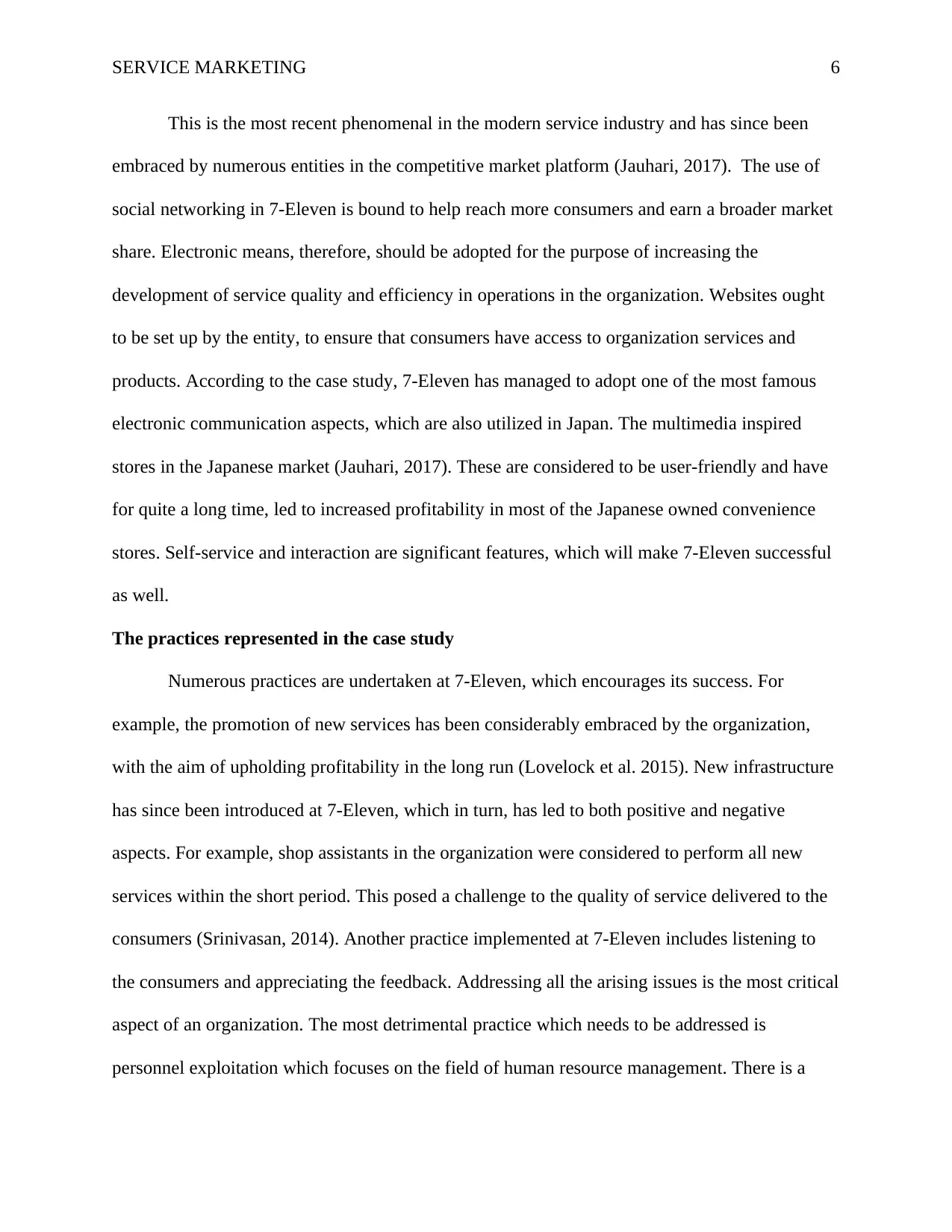
SERVICE MARKETING 6
This is the most recent phenomenal in the modern service industry and has since been
embraced by numerous entities in the competitive market platform (Jauhari, 2017). The use of
social networking in 7-Eleven is bound to help reach more consumers and earn a broader market
share. Electronic means, therefore, should be adopted for the purpose of increasing the
development of service quality and efficiency in operations in the organization. Websites ought
to be set up by the entity, to ensure that consumers have access to organization services and
products. According to the case study, 7-Eleven has managed to adopt one of the most famous
electronic communication aspects, which are also utilized in Japan. The multimedia inspired
stores in the Japanese market (Jauhari, 2017). These are considered to be user-friendly and have
for quite a long time, led to increased profitability in most of the Japanese owned convenience
stores. Self-service and interaction are significant features, which will make 7-Eleven successful
as well.
The practices represented in the case study
Numerous practices are undertaken at 7-Eleven, which encourages its success. For
example, the promotion of new services has been considerably embraced by the organization,
with the aim of upholding profitability in the long run (Lovelock et al. 2015). New infrastructure
has since been introduced at 7-Eleven, which in turn, has led to both positive and negative
aspects. For example, shop assistants in the organization were considered to perform all new
services within the short period. This posed a challenge to the quality of service delivered to the
consumers (Srinivasan, 2014). Another practice implemented at 7-Eleven includes listening to
the consumers and appreciating the feedback. Addressing all the arising issues is the most critical
aspect of an organization. The most detrimental practice which needs to be addressed is
personnel exploitation which focuses on the field of human resource management. There is a
This is the most recent phenomenal in the modern service industry and has since been
embraced by numerous entities in the competitive market platform (Jauhari, 2017). The use of
social networking in 7-Eleven is bound to help reach more consumers and earn a broader market
share. Electronic means, therefore, should be adopted for the purpose of increasing the
development of service quality and efficiency in operations in the organization. Websites ought
to be set up by the entity, to ensure that consumers have access to organization services and
products. According to the case study, 7-Eleven has managed to adopt one of the most famous
electronic communication aspects, which are also utilized in Japan. The multimedia inspired
stores in the Japanese market (Jauhari, 2017). These are considered to be user-friendly and have
for quite a long time, led to increased profitability in most of the Japanese owned convenience
stores. Self-service and interaction are significant features, which will make 7-Eleven successful
as well.
The practices represented in the case study
Numerous practices are undertaken at 7-Eleven, which encourages its success. For
example, the promotion of new services has been considerably embraced by the organization,
with the aim of upholding profitability in the long run (Lovelock et al. 2015). New infrastructure
has since been introduced at 7-Eleven, which in turn, has led to both positive and negative
aspects. For example, shop assistants in the organization were considered to perform all new
services within the short period. This posed a challenge to the quality of service delivered to the
consumers (Srinivasan, 2014). Another practice implemented at 7-Eleven includes listening to
the consumers and appreciating the feedback. Addressing all the arising issues is the most critical
aspect of an organization. The most detrimental practice which needs to be addressed is
personnel exploitation which focuses on the field of human resource management. There is a
⊘ This is a preview!⊘
Do you want full access?
Subscribe today to unlock all pages.

Trusted by 1+ million students worldwide
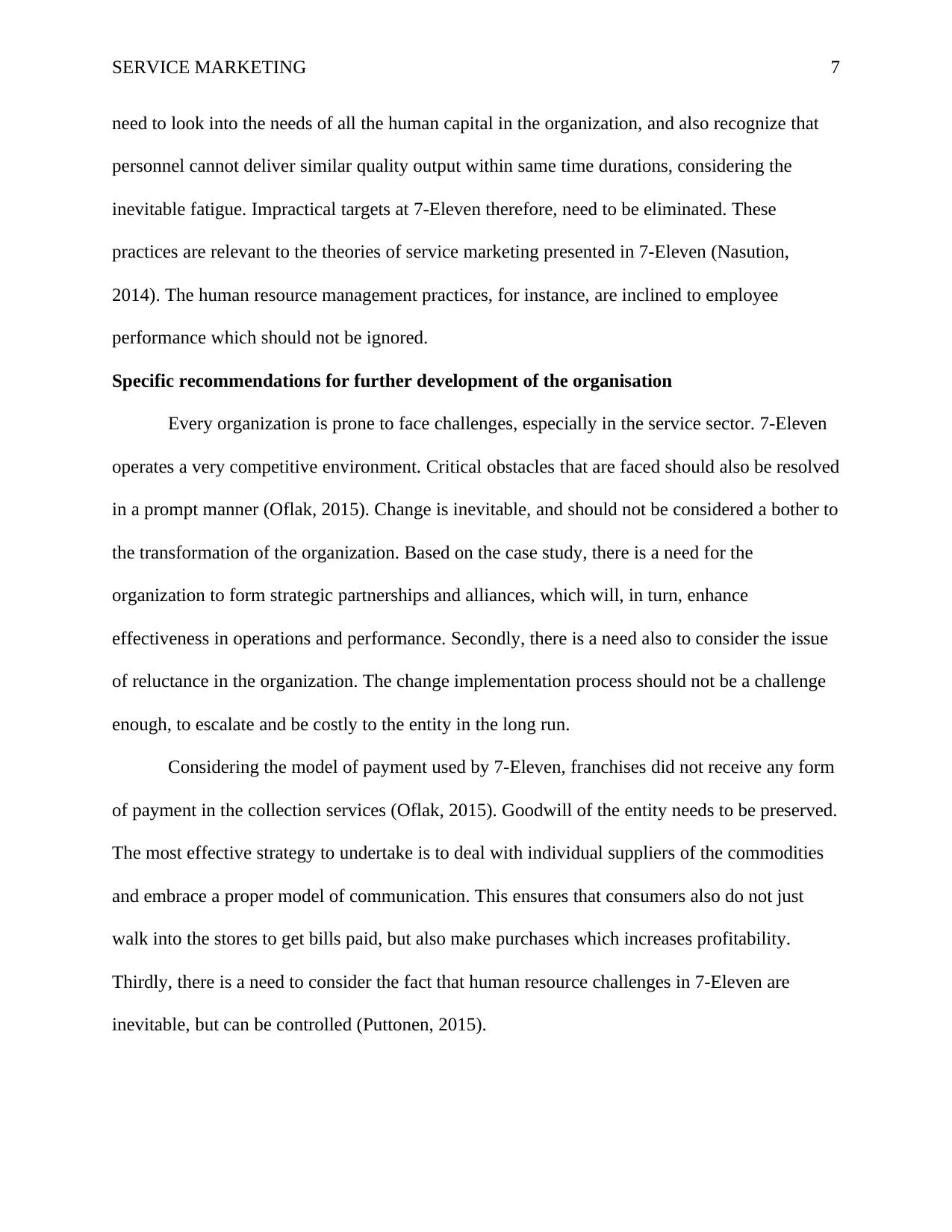
SERVICE MARKETING 7
need to look into the needs of all the human capital in the organization, and also recognize that
personnel cannot deliver similar quality output within same time durations, considering the
inevitable fatigue. Impractical targets at 7-Eleven therefore, need to be eliminated. These
practices are relevant to the theories of service marketing presented in 7-Eleven (Nasution,
2014). The human resource management practices, for instance, are inclined to employee
performance which should not be ignored.
Specific recommendations for further development of the organisation
Every organization is prone to face challenges, especially in the service sector. 7-Eleven
operates a very competitive environment. Critical obstacles that are faced should also be resolved
in a prompt manner (Oflak, 2015). Change is inevitable, and should not be considered a bother to
the transformation of the organization. Based on the case study, there is a need for the
organization to form strategic partnerships and alliances, which will, in turn, enhance
effectiveness in operations and performance. Secondly, there is a need also to consider the issue
of reluctance in the organization. The change implementation process should not be a challenge
enough, to escalate and be costly to the entity in the long run.
Considering the model of payment used by 7-Eleven, franchises did not receive any form
of payment in the collection services (Oflak, 2015). Goodwill of the entity needs to be preserved.
The most effective strategy to undertake is to deal with individual suppliers of the commodities
and embrace a proper model of communication. This ensures that consumers also do not just
walk into the stores to get bills paid, but also make purchases which increases profitability.
Thirdly, there is a need to consider the fact that human resource challenges in 7-Eleven are
inevitable, but can be controlled (Puttonen, 2015).
need to look into the needs of all the human capital in the organization, and also recognize that
personnel cannot deliver similar quality output within same time durations, considering the
inevitable fatigue. Impractical targets at 7-Eleven therefore, need to be eliminated. These
practices are relevant to the theories of service marketing presented in 7-Eleven (Nasution,
2014). The human resource management practices, for instance, are inclined to employee
performance which should not be ignored.
Specific recommendations for further development of the organisation
Every organization is prone to face challenges, especially in the service sector. 7-Eleven
operates a very competitive environment. Critical obstacles that are faced should also be resolved
in a prompt manner (Oflak, 2015). Change is inevitable, and should not be considered a bother to
the transformation of the organization. Based on the case study, there is a need for the
organization to form strategic partnerships and alliances, which will, in turn, enhance
effectiveness in operations and performance. Secondly, there is a need also to consider the issue
of reluctance in the organization. The change implementation process should not be a challenge
enough, to escalate and be costly to the entity in the long run.
Considering the model of payment used by 7-Eleven, franchises did not receive any form
of payment in the collection services (Oflak, 2015). Goodwill of the entity needs to be preserved.
The most effective strategy to undertake is to deal with individual suppliers of the commodities
and embrace a proper model of communication. This ensures that consumers also do not just
walk into the stores to get bills paid, but also make purchases which increases profitability.
Thirdly, there is a need to consider the fact that human resource challenges in 7-Eleven are
inevitable, but can be controlled (Puttonen, 2015).
Paraphrase This Document
Need a fresh take? Get an instant paraphrase of this document with our AI Paraphraser
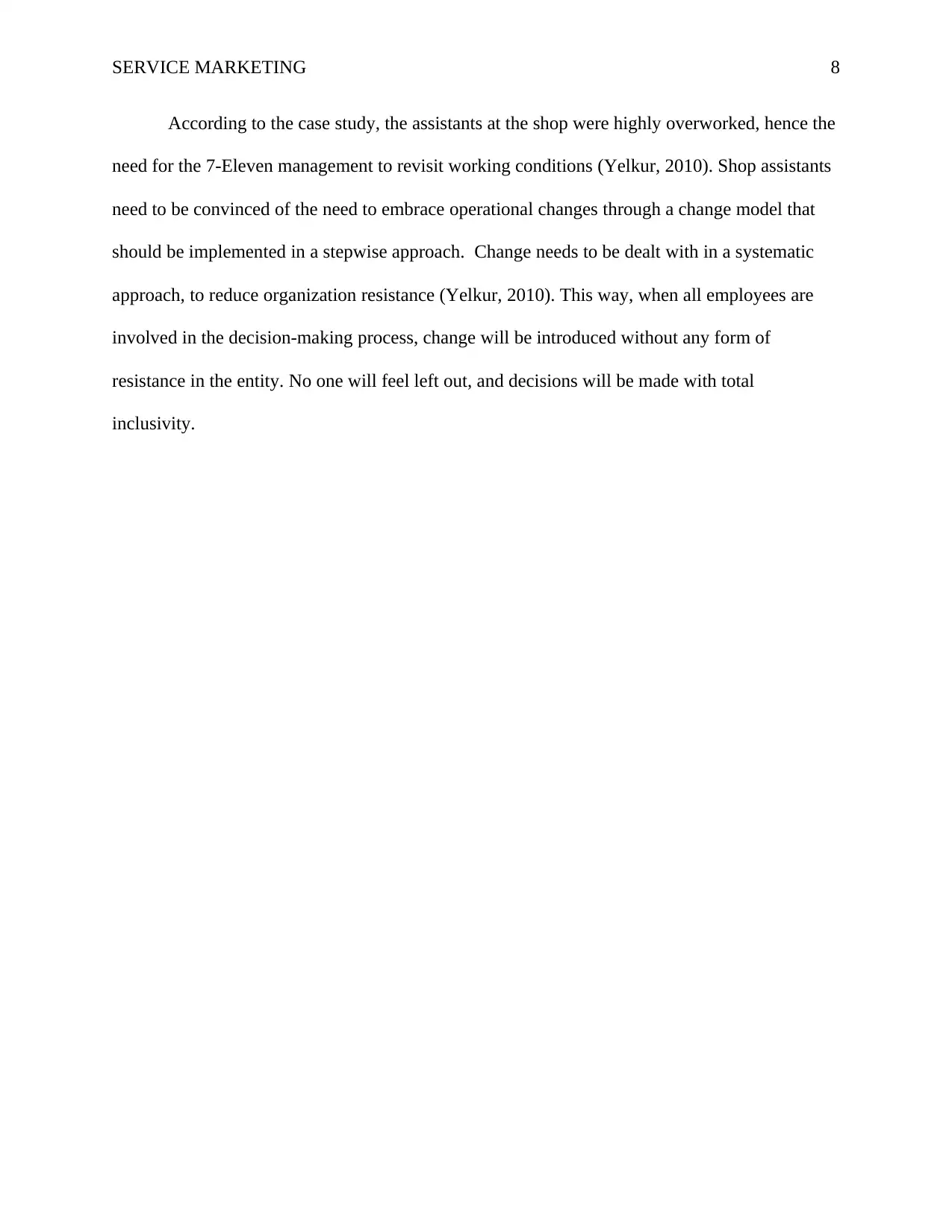
SERVICE MARKETING 8
According to the case study, the assistants at the shop were highly overworked, hence the
need for the 7-Eleven management to revisit working conditions (Yelkur, 2010). Shop assistants
need to be convinced of the need to embrace operational changes through a change model that
should be implemented in a stepwise approach. Change needs to be dealt with in a systematic
approach, to reduce organization resistance (Yelkur, 2010). This way, when all employees are
involved in the decision-making process, change will be introduced without any form of
resistance in the entity. No one will feel left out, and decisions will be made with total
inclusivity.
According to the case study, the assistants at the shop were highly overworked, hence the
need for the 7-Eleven management to revisit working conditions (Yelkur, 2010). Shop assistants
need to be convinced of the need to embrace operational changes through a change model that
should be implemented in a stepwise approach. Change needs to be dealt with in a systematic
approach, to reduce organization resistance (Yelkur, 2010). This way, when all employees are
involved in the decision-making process, change will be introduced without any form of
resistance in the entity. No one will feel left out, and decisions will be made with total
inclusivity.
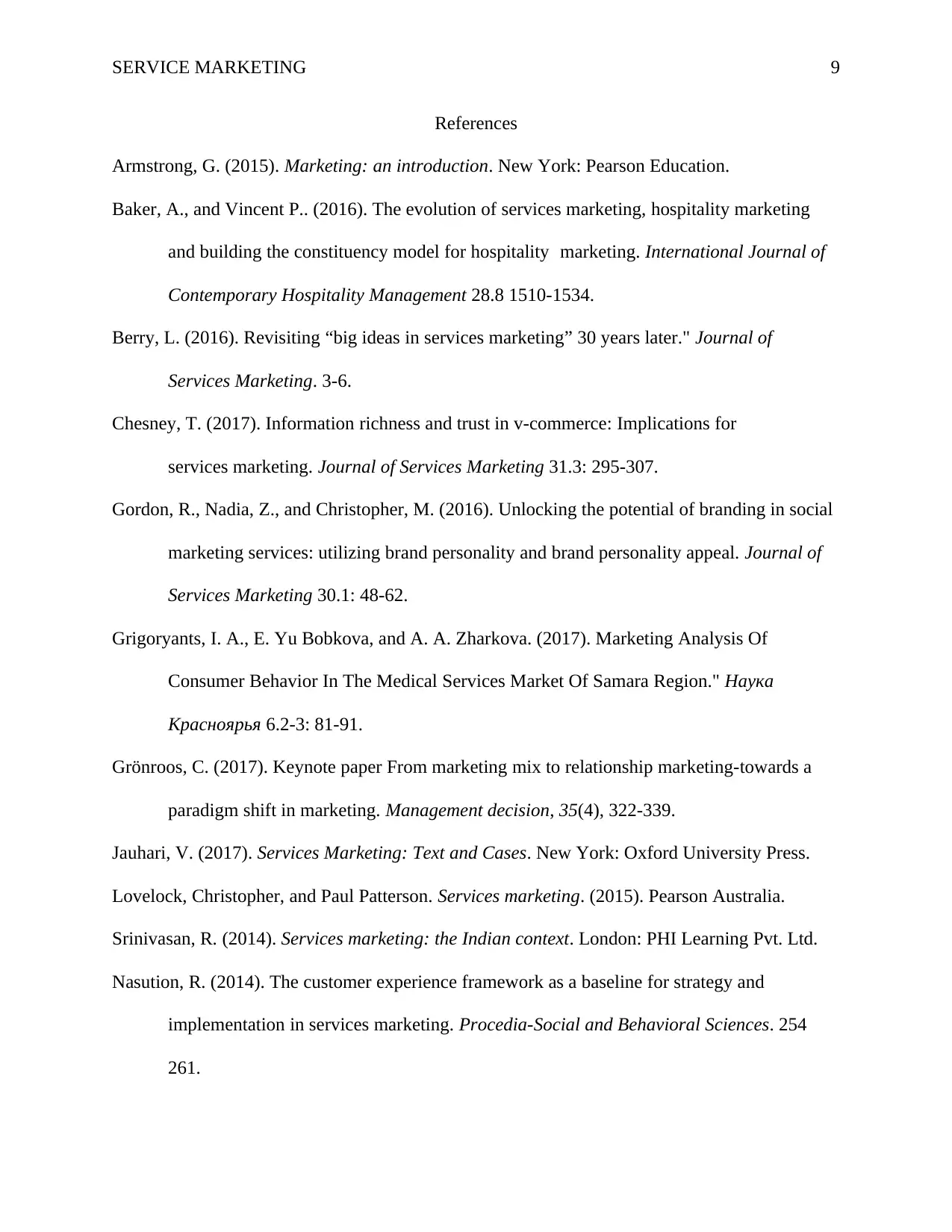
SERVICE MARKETING 9
References
Armstrong, G. (2015). Marketing: an introduction. New York: Pearson Education.
Baker, A., and Vincent P.. (2016). The evolution of services marketing, hospitality marketing
and building the constituency model for hospitality marketing. International Journal of
Contemporary Hospitality Management 28.8 1510-1534.
Berry, L. (2016). Revisiting “big ideas in services marketing” 30 years later." Journal of
Services Marketing. 3-6.
Chesney, T. (2017). Information richness and trust in v-commerce: Implications for
services marketing. Journal of Services Marketing 31.3: 295-307.
Gordon, R., Nadia, Z., and Christopher, M. (2016). Unlocking the potential of branding in social
marketing services: utilizing brand personality and brand personality appeal. Journal of
Services Marketing 30.1: 48-62.
Grigoryants, I. A., E. Yu Bobkova, and A. A. Zharkova. (2017). Marketing Analysis Of
Consumer Behavior In The Medical Services Market Of Samara Region." Наука
Красноярья 6.2-3: 81-91.
Grönroos, C. (2017). Keynote paper From marketing mix to relationship marketing-towards a
paradigm shift in marketing. Management decision, 35(4), 322-339.
Jauhari, V. (2017). Services Marketing: Text and Cases. New York: Oxford University Press.
Lovelock, Christopher, and Paul Patterson. Services marketing. (2015). Pearson Australia.
Srinivasan, R. (2014). Services marketing: the Indian context. London: PHI Learning Pvt. Ltd.
Nasution, R. (2014). The customer experience framework as a baseline for strategy and
implementation in services marketing. Procedia-Social and Behavioral Sciences. 254
261.
References
Armstrong, G. (2015). Marketing: an introduction. New York: Pearson Education.
Baker, A., and Vincent P.. (2016). The evolution of services marketing, hospitality marketing
and building the constituency model for hospitality marketing. International Journal of
Contemporary Hospitality Management 28.8 1510-1534.
Berry, L. (2016). Revisiting “big ideas in services marketing” 30 years later." Journal of
Services Marketing. 3-6.
Chesney, T. (2017). Information richness and trust in v-commerce: Implications for
services marketing. Journal of Services Marketing 31.3: 295-307.
Gordon, R., Nadia, Z., and Christopher, M. (2016). Unlocking the potential of branding in social
marketing services: utilizing brand personality and brand personality appeal. Journal of
Services Marketing 30.1: 48-62.
Grigoryants, I. A., E. Yu Bobkova, and A. A. Zharkova. (2017). Marketing Analysis Of
Consumer Behavior In The Medical Services Market Of Samara Region." Наука
Красноярья 6.2-3: 81-91.
Grönroos, C. (2017). Keynote paper From marketing mix to relationship marketing-towards a
paradigm shift in marketing. Management decision, 35(4), 322-339.
Jauhari, V. (2017). Services Marketing: Text and Cases. New York: Oxford University Press.
Lovelock, Christopher, and Paul Patterson. Services marketing. (2015). Pearson Australia.
Srinivasan, R. (2014). Services marketing: the Indian context. London: PHI Learning Pvt. Ltd.
Nasution, R. (2014). The customer experience framework as a baseline for strategy and
implementation in services marketing. Procedia-Social and Behavioral Sciences. 254
261.
⊘ This is a preview!⊘
Do you want full access?
Subscribe today to unlock all pages.

Trusted by 1+ million students worldwide
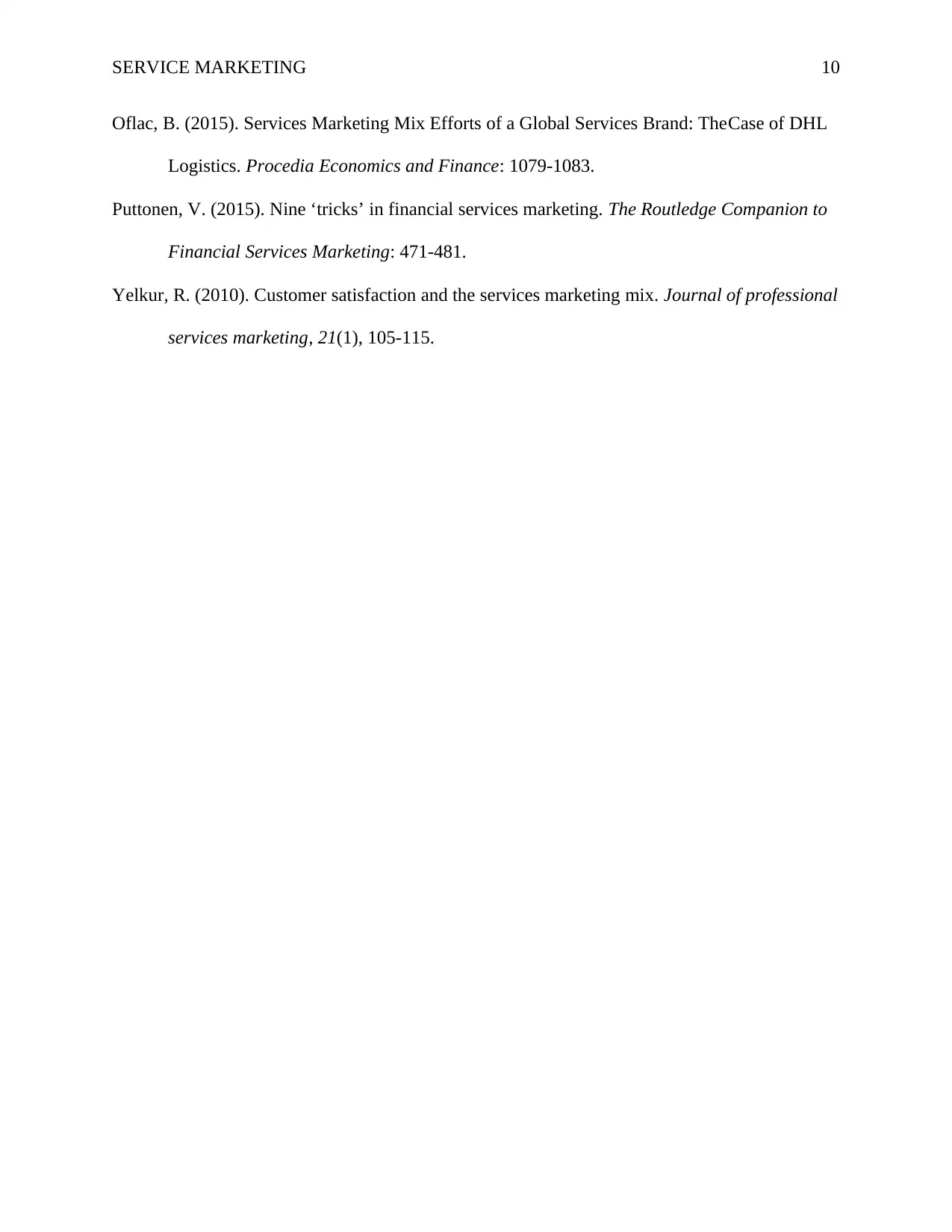
SERVICE MARKETING 10
Oflac, B. (2015). Services Marketing Mix Efforts of a Global Services Brand: TheCase of DHL
Logistics. Procedia Economics and Finance: 1079-1083.
Puttonen, V. (2015). Nine ‘tricks’ in financial services marketing. The Routledge Companion to
Financial Services Marketing: 471-481.
Yelkur, R. (2010). Customer satisfaction and the services marketing mix. Journal of professional
services marketing, 21(1), 105-115.
Oflac, B. (2015). Services Marketing Mix Efforts of a Global Services Brand: TheCase of DHL
Logistics. Procedia Economics and Finance: 1079-1083.
Puttonen, V. (2015). Nine ‘tricks’ in financial services marketing. The Routledge Companion to
Financial Services Marketing: 471-481.
Yelkur, R. (2010). Customer satisfaction and the services marketing mix. Journal of professional
services marketing, 21(1), 105-115.
1 out of 10
Related Documents
Your All-in-One AI-Powered Toolkit for Academic Success.
+13062052269
info@desklib.com
Available 24*7 on WhatsApp / Email
![[object Object]](/_next/static/media/star-bottom.7253800d.svg)
Unlock your academic potential
Copyright © 2020–2025 A2Z Services. All Rights Reserved. Developed and managed by ZUCOL.




